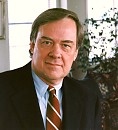
|
The Portrait Society of America is pleased
to present a feature article on the work of John Howard Sanden
who has been in the forefront as a teacher. He and his wife
Elizabeth have pioneered the type of teaching seminars that
have been held in recent years. He is a valued friend and
mentor, as he has been to many artists.
Gordon Wetmore
Chairman, Portrait Society of America |

